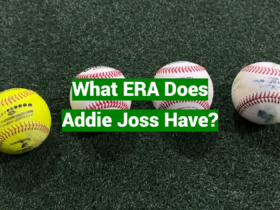In the intricate tapestry of baseball statistics, Earned Run Average (ERA) stands as a linchpin, providing a succinct measure of a pitcher’s effectiveness on the mound. But what defines a good ERA in the dynamic landscape of America’s pastime? This article delves into the nuanced factors that shape our understanding of a “good” ERA, exploring the influence of ballparks, weather conditions, and the pitcher’s individual ability.
From the hallowed history of record-setting ERAs to contemporary benchmarks, we unravel the intricacies surrounding this critical statistic, offering insights into the ever-evolving standards that govern excellence in the world of baseball pitching.
Table of Contents
What Is ERA In Baseball?
Earned runs, the key element here, exclude runs scored due to defensive errors or wild pitches, focusing solely on those directly attributed to the pitcher’s performance. The formula for calculating ERA is 9 x Earned Runs / Innings Pitched. A lower ERA indicates a superior pitcher, as they are limiting opponents from crossing the plate with consistent efficiency [1].

Understanding the Earned Distinction:
The differentiation between earned and unearned runs is crucial. Imagine a scenario where a batter reaches base due to a fielding error, advances on a wild pitch, and eventually scores. Despite the run technically “scoring” on the pitcher’s watch, the defensive miscue played a significant role, hence it wouldn’t be counted as an earned run. This separation ensures ERA isolates the pitcher’s skill, offering a fairer assessment of their pitching ability.
Delving into the Details:
ERA, while valuable, presents a simplified picture. Deeper analysis requires considering factors like the league average ERA, ballpark effects, and a pitcher’s performance against specific teams or batters. For instance, a 3.00 ERA in a hitter-friendly ballpark might be more impressive than a 2.50 ERA in a pitcher’s haven. Additionally, a pitcher’s ERA against left-handed hitters compared to right-handed hitters provides valuable insights into their strengths and weaknesses [2].
Beyond the Surface:
While ERA remains a cornerstone statistic, advanced metrics have emerged to offer a more comprehensive picture of pitching performance. Metrics like FIP (Fielding Independent Pitching) and WHIP (Walks + Hits per Innings Pitched) isolate factors beyond a pitcher’s control, providing a deeper understanding of their true talent level. However, ERA remains a readily available and easily digestible metric, making it a valuable starting point for evaluating pitchers.
Historical Context:
ERA has stood the test of time, evolving alongside the game itself. The 19th century saw average ERAs exceeding 4.00, reflecting the dominance of hitters. As pitching strategies and equipment improved, ERAs dropped steadily, with the “dead-ball era” of the 1920s seeing sub-3.00 ERAs become commonplace [3]. The modern era presents a more balanced offensive and defensive landscape, with league-average ERAs typically hovering around 4.00.
The Impact on the Game:
ERA plays a significant role in various aspects of baseball. Teams consider it heavily when evaluating pitchers for trades, free agency, and contract negotiations. Starting pitchers who consistently boast low ERAs become valuable assets, leading their teams to victory. Additionally, fans utilize ERA to compare pitchers, track individual and team success, and engage in heated debates about who deserves prestigious awards like the Cy Young.

Beyond the Numbers:
It’s important to remember that ERA, despite its significance, is just one piece of the puzzle. A pitcher’s mental toughness, ability to adjust in-game, and leadership qualities all contribute to their success. Additionally, the human element of the sport comes into play – bad days happen even to the best pitchers, and a single poor outing shouldn’t define their entire season.
What Is ERA+ In Baseball?
For example, a pitcher playing in a hitter-friendly ballpark or facing a particularly strong-hitting team will naturally have a higher ERA compared to someone pitching in a pitcher’s paradise against weaker competition.
This is where ERA+ comes in. It takes a pitcher’s ERA and adjusts it based on two key factors:
- League Average ERA: This accounts for the overall offensive environment of the league. If the league average ERA is high, it indicates scoring is easier, making a pitcher’s sub-par ERA more impressive;
- Park Factor: Different ballparks favor hitters or pitchers due to factors like dimensions, altitude, and wind patterns. ERA+ adjusts for these differences, ensuring a more accurate comparison [4];
The Interpretation:
By factoring in these external influences, ERA+ provides a standardized score. 100 is considered league average, meaning a pitcher performs exactly as expected given the league and their ballpark:
- A score above 100 indicates a better-than-average performance, with each point representing a 1% improvement over the league average. For example, an ERA+ of 120 signifies a pitcher is 20% better than the league average;
- A score below 100 indicates worse-than-average performance. The lower the score, the further behind the league average the pitcher falls;

The Benefits:
- Fairer Comparisons: It allows for accurate comparisons between pitchers across different leagues, ballparks, and eras. Imagine comparing Pedro Martinez’s 2.93 ERA in the hitter-friendly Fenway Park to Jacob deGrom’s 2.55 ERA in the pitcher-friendly Citi Field. Their ERA+ paints a clearer picture: Martinez at 147 and deGrom at 148, highlighting their similar dominance despite different contexts;
- Identifying Under-the-Radar Gems: A pitcher with a low ERA in a tough environment might go unnoticed based solely on ERA. ERA+ shines a light on these hidden talents;
- Tracking Improvement: Monitoring a pitcher’s ERA+ over time can reveal if they are genuinely improving or just benefiting from favorable circumstances;
Beyond ERA+:
While valuable, ERA+ is not a perfect metric. It doesn’t account for all factors influencing pitching performance, like a pitcher’s specific matchups or control issues. Additionally, other advanced metrics like FIP (Fielding Independent Pitching) delve deeper into pitcher skill by isolating factors beyond their control.
How Is ERA Calculated?
Earned Run Average (ERA) is a crucial statistic in baseball that quantifies a pitcher’s performance by measuring the average number of earned runs they allow per nine innings pitched. The formula for calculating ERA is relatively straightforward, using two essential variables: earned runs and innings pitched.
The formula for calculating ERA is as follows:
ERA = (Earned Runs/Innings Pitched) × 9
Let’s break down the components of this formula [5]:
Earned Runs (ER):
Earned runs are runs that are scored without the aid of errors, passed balls, or defensive mistakes. Only runs directly attributed to the pitcher’s performance are considered earned.
Innings Pitched (IP):
Innings pitched represent the total number of innings a pitcher has completed. In baseball, each inning consists of three outs, and a standard game comprises nine innings. However, the formula normalizes the earned runs over a nine-inning period, regardless of how many innings the pitcher has actually played.
Normalization to Nine Innings:
The multiplication of the earned runs divided by innings pitched by 9 is essential for standardizing the statistic to a nine-inning game. This normalization allows for easy comparison across different pitchers and teams, as it provides a consistent metric.

Let’s go through a simple example to illustrate the calculation:
Suppose a pitcher has allowed 20 earned runs in 100 innings pitched. The calculation of ERA would be as follows:
Therefore, the pitcher’s Earned Run Average would be 1.8 in this example.
It’s important to note that a lower ERA is generally considered better, as it indicates that the pitcher is more effective at preventing runs. However, ERA does have its limitations, as it doesn’t account for factors such as defensive performance, the quality of opposing hitters, or the context in which runs are scored.
As a result, analysts often use additional metrics like Fielding Independent Pitching (FIP) or Adjusted ERA (ERA+) to provide a more comprehensive evaluation of a pitcher’s performance [6].
Why Is The Baseball ERA Stat Important?
Earned Run Average (ERA) is a pivotal statistic in baseball that holds significant importance for players, teams, analysts, and fans alike.
Here are several reasons why the ERA stat is considered crucial in the world of baseball:
Pitcher Performance Measurement:
ERA is a primary metric for evaluating a pitcher’s overall performance on the field. It provides a concise and easily understandable measure of a pitcher’s effectiveness in preventing opponents from scoring runs.
Pitcher Comparison:
ERA allows for a straightforward comparison of pitchers across different teams and eras. A lower ERA generally indicates a more effective pitcher, making it a valuable tool for assessing and comparing player performance.
Team Decision-Making:
Teams heavily rely on ERA when making decisions about their pitching staff. It influences decisions about starting rotations, bullpen usage, and player acquisitions or trades. A pitcher with a consistently low ERA is often seen as a reliable asset to the team.
Player Contracts and Salaries:
Players’ salaries are often influenced by their statistical performance, and ERA is a key factor in contract negotiations. Pitchers with impressive ERAs are likely to command higher salaries in the competitive landscape of professional baseball.

Fan Engagement:
For fans, ERA serves as an easily digestible metric to assess a pitcher’s contribution to the team. Fans can quickly gauge a pitcher’s effectiveness and use ERA to discuss and analyze player performance.
Historical Context:
ERA has a long history in baseball, making it a valuable tool for comparing players across different eras. It provides a historical context for understanding changes in the game and how pitching strategies have evolved over time.
Awards and Recognition:
Several prestigious awards, such as the Cy Young Award, which honors the best pitchers in Major League Baseball, heavily consider a pitcher’s ERA. Winning or leading in ERA can significantly enhance a player’s chances of receiving accolades and recognition.
Efficiency Indicator:
ERA not only reflects a pitcher’s ability to prevent runs but also serves as an indicator of their efficiency. A pitcher with a low ERA is often efficient in managing innings, limiting base runners, and minimizing the impact of hits and walks.
Game Strategy:
Coaches and managers use ERA to develop game strategies. Understanding the strengths and weaknesses of their pitchers, as reflected in their ERAs, helps teams make informed decisions about matchups, substitutions, and defensive alignments.
Fantasy Baseball:
In fantasy baseball leagues, ERA is a critical statistical category. Team managers often build their pitching staffs around pitchers with strong ERAs to accumulate points and compete successfully in their leagues.
Understanding the Significance of ERA:
ERA and Pitcher Performance:

Pitchers strive for a low ERA as it not only contributes to personal success but also enhances their market value. Teams seek pitchers with a track record of maintaining low ERAs, recognizing them as assets that can positively impact the team’s success. Therefore, ERA becomes a critical factor in contract negotiations, player acquisitions, and the shaping of pitching rotations.
ERA and Team Success:
The relationship between a team’s success and the collective ERAs of its pitchers is undeniable. Teams with a strong pitching staff characterized by low ERAs often find themselves in favorable positions. Pitchers who consistently deliver solid performances contribute significantly to a team’s ability to win games. As a result, team management places great emphasis on cultivating a pitching roster that can collectively maintain a competitive ERA.
In the pursuit of championships, teams strategize around pitching, recognizing that a low team ERA can compensate for offensive shortcomings. Postseason success, in particular, is often linked to the performance of a team’s pitching staff, making ERA a crucial factor in the quest for baseball glory.
ERA Baseball Stats and Historical Trends:
The evolution of ERA over the years reflects the dynamic nature of baseball. Different eras in the sport’s history, from the “Dead Ball Era” to the modern era of power-hitting, have witnessed shifts in offensive and defensive strategies. ERA adapts to these changes, providing a lens through which we can observe the transformation of the game [7].
Analyzing historical ERA trends allows baseball enthusiasts to appreciate the nuances of each era. Lower ERAs in certain periods may highlight pitching dominance, while higher ERAs might signify offensive explosions. Understanding these trends contributes to a more comprehensive appreciation of the sport’s evolution and the impact of rule changes, equipment advancements, and strategic innovations on pitching performance.

Earned Runs vs. Unearned Runs:
1) Earned Runs:
Definition:
Earned runs are runs that are scored without the aid of defensive errors, passed balls, or other fielding mistakes. These are the runs attributed solely to the offensive prowess of the opposing team and the pitcher’s ability to prevent them.
Calculation:
To calculate earned runs, one considers the runs that score as a direct result of hits, walks, hit batters, and certain defensive plays. If a runner reaches base due to an error but later scores, that run is still considered earned because the pitcher should have gotten the batter out, and the subsequent scoring is a consequence of the offensive play.
Significance:
Earned runs are a critical component of a pitcher’s performance evaluation. They directly reflect the pitcher’s effectiveness in preventing runs, irrespective of defensive lapses. A low earned run count is indicative of a pitcher’s skill in controlling the game, limiting the impact of hits and walks.
2) Unearned Runs:
Definition:
Unearned runs are runs that result from defensive errors or other fielding mishaps. These runs are not attributed to the pitcher’s performance but are rather a consequence of mistakes made by the defensive players.

Calculation:
Unearned runs are calculated by tallying the runs that score due to errors, passed balls, or other defensive miscues. If a runner reaches base or a play is extended due to an error, and that runner subsequently scores, the run is deemed unearned.
Significance:
While unearned runs do not directly impact a pitcher’s ERA, they are crucial in assessing the overall defensive performance of a team. Pitchers are not held responsible for unearned runs in the ERA calculation, but defensive lapses can still influence the outcome of a game. Teams strive to minimize unearned runs by emphasizing sound defensive play and maintaining the integrity of the fielding unit.
What Is A Good ERA In Baseball – Key Factors:
Ballpark:
One of the factors that significantly affects ERA is the ballpark in which a pitcher performs. Ballparks vary in dimensions, outfield wall heights, and atmospheric conditions, all of which can impact the number of runs scored. A pitcher’s home ballpark, often tailored to their strengths or weaknesses, can play a pivotal role in shaping their ERA.
Pitchers in hitter-friendly parks, characterized by shorter fences and favorable weather conditions, may see their ERAs rise as more runs are scored overall. On the contrary, those in pitcher-friendly parks, with expansive outfields and higher walls, might enjoy lower ERAs. Adjusting for these ballpark factors is crucial when evaluating a pitcher’s performance and determining what constitutes a good ERA.
Weather Conditions:
Weather conditions, both on a daily and seasonal basis, have a substantial impact on ERA. Changes in temperature, wind speed, and humidity can influence how the ball travels and behaves. Warm and dry conditions tend to favor hitters, leading to more home runs and potentially higher ERAs. Conversely, cooler temperatures and strong winds may benefit pitchers, resulting in lower ERAs.
Moreover, pitchers often need to adapt their strategies based on weather conditions. For instance, in cold weather, the ball may not travel as far, requiring pitchers to focus on inducing ground balls rather than relying on strikeouts. Considering the prevailing weather conditions adds a layer of complexity when assessing the significance of ERA in different contexts.
Pitcher Ability:
The heart of the ERA discussion revolves around the pitcher’s ability. A good ERA is ultimately a reflection of a pitcher’s skill in preventing runs, regardless of external factors. Key components of a pitcher’s ability include command of different pitches, strikeout capability, control over walks, and the ability to induce groundouts or pop-ups.
An elite pitcher with exceptional control and a diverse repertoire of pitches may maintain a low ERA even in challenging conditions or hitter-friendly ballparks. On the other hand, a pitcher with less refined skills may struggle to keep their ERA down, even in favorable circumstances. The pitcher’s ability, therefore, stands as a fundamental factor in determining what constitutes a good ERA.

Average ERA:
Understanding what is considered average in terms of ERA provides a benchmark for evaluating individual performances. Over the years, the league-wide average ERA has fluctuated, influenced by rule changes, offensive strategies, and advancements in player conditioning.
Analyzing the league average ERA helps contextualize individual pitcher performances. If a pitcher’s ERA is significantly lower than the league average, it indicates exceptional performance. Conversely, an ERA higher than the league average may raise questions about a pitcher’s effectiveness relative to their peers.
Is An ERA Between 3.00 – 4.00 Considered Good?
Pitchers consistently maintaining an ERA below 3.00 are often regarded as elite, showcasing a high level of skill in preventing earned runs. On the other hand, an ERA above 4.00 may raise some concerns, suggesting that the pitcher is allowing a relatively higher number of runs.
While an ERA between 3.00 and 4.00 is a commonly accepted benchmark, it’s essential to consider the contextual factors mentioned earlier. A pitcher operating in a hitter-friendly park or adverse weather conditions may still be performing admirably with an ERA in this range.
Why a Low ERA is Better Than a High ERA?
A low ERA is inherently better than a high ERA because it signifies a pitcher’s ability to limit the opposition’s scoring. In the context of ERA, lower values indicate superior performance, showcasing the pitcher’s command over the game. A low ERA is often synonymous with excellent control, effective pitch selection, and the capability to neutralize opposing hitters.
From a team perspective, pitchers with low ERAs contribute significantly to the overall success of the squad. They provide a reliable foundation, keeping games close and offering the offense an opportunity to secure victories. Teams prioritize acquiring and retaining pitchers with consistently low ERAs as they are perceived as valuable assets in the competitive landscape of professional baseball.
How Is ERA Different for a Starter vs. Reliever?
The role of a pitcher, whether a starter or reliever, has a profound impact on their ERA. Starters, who typically pitch more innings in a game, face different challenges than relievers who come into the game for shorter stints.
Starting pitchers aim for lower ERAs due to the extended time they spend on the mound. An ERA around 3.00 for a starting pitcher is often considered excellent, as they navigate through multiple innings and face a team’s lineup multiple times in a game.
Relievers, on the other hand, might have slightly higher ERAs. Their appearances are shorter, and they often enter the game in high-pressure situations. An ERA between 3.00 and 4.00 can still be considered solid for a reliever, considering the specialized nature of their role.
Understanding the nuances of ERA for starters and relievers is crucial when evaluating pitching performances, as the expectations and challenges associated with each role differ significantly.

Who Has The Highest ERA In Baseball?
While low ERAs are celebrated, the highest ERA in baseball often draws attention for different reasons. The pitcher with the highest ERA may face challenges in adapting to the level of competition, dealing with injuries, or adjusting to the nuances of Major League Baseball.
As of the latest available data, identifying the specific pitcher with the highest ERA may vary based on the ongoing season. Baseball is dynamic, and player performances can change over time. The pitcher with the highest ERA becomes a focal point of discussions around team strategies, potential improvements, and the dynamic nature of the sport.
FAQ:
1. Who has the lowest ERA in history?
Dutch Leonard holds the record for the lowest single-season ERA in Major League Baseball history with an astounding 0.96 in 1914.
2. What is a good ERA in Major League Baseball?
Generally, an ERA between 3.00 and 4.00 is considered solid in Major League Baseball. However, context, including ballpark factors and league averages, should be considered when evaluating individual performances.
3. What is a good ERA in college/high school baseball?
In college and high school baseball, where offensive and defensive dynamics may differ, what constitutes a good ERA can vary. Typically, a sub-3.00 ERA is considered excellent at these levels.
4. What is a good career ERA in baseball?
A good career ERA in baseball is often below 3.00. Hall of Fame pitchers often maintain career ERAs in the 2.00 to 3.00 range, showcasing sustained excellence over their careers.
5. Can you have a zero ERA?
In theory, a pitcher can have a zero ERA if they complete an entire season without allowing an earned run. However, achieving this is extremely rare due to the unpredictable nature of the game.
6. What is the highest possible ERA?
The highest possible ERA is technically infinite if a pitcher faces one batter and allows an infinite number of runs. In practical terms, a very high ERA is indicative of significant struggles on the mound.
7. What are the drawbacks to ERA as a stat?
Drawbacks to ERA include its dependence on team defense, variability in ballpark factors, and the exclusion of unearned runs. It doesn’t provide a complete picture of a pitcher’s individual performance.
8. Is a balk an earned run?
No, a balk is not considered an earned run. It is a pitching violation resulting in baserunners advancing, but any runs scored due to a balk are considered unearned.
9. Is a 1.8 ERA good?
Yes, a 1.8 ERA is excellent. It indicates that a pitcher allows, on average, only 1.8 earned runs per nine innings pitched.
10. Is a 3.93 ERA good?
A 3.93 ERA is generally considered average in Major League Baseball. Performance expectations can vary based on the era and offensive environment.
11. Is 6.75 a good ERA?
A 6.75 ERA is higher than average and suggests a pitcher is struggling. It is often associated with difficulties in preventing runs effectively.
12. Is a 3.00 ERA good?
Yes, a 3.00 ERA is considered good in Major League Baseball. Pitchers with ERAs around 3.00 are often regarded as solid contributors.
13. Is a 2.95 ERA good?
Yes, a 2.95 ERA is considered good. It falls within the range of elite performance and showcases a pitcher’s ability to limit runs.
14. Is a 1.12 ERA good?
A 1.12 ERA is exceptional and indicative of a dominant pitcher. It reflects an elite level of performance on the mound.
15. Is a 6.00 ERA good?
A 6.00 ERA is above average and may suggest struggles in preventing runs. It is generally considered on the higher side.
16. Who has the best ERA ever?
Dutch Leonard’s 0.96 ERA in 1914 is recognized as the lowest single-season ERA in MLB history.
17. What does “G” mean in baseball?
In baseball statistics, “G” typically represents the total number of games played by a player, including both starts and appearances as a substitute.
18. Who has the lowest ERA with 200 wins?
Whitey Ford holds the record for the lowest career ERA among pitchers with 200 or more wins, with a 2.75 ERA over his illustrious career.
19. Why is ERA multiplied by 9?
Multiplying ERA by 9 standardizes the statistic to represent the average number of earned runs a pitcher would allow over a full nine-inning game.
20. Who has the lowest ERA in the MLB as of 2023?
For real-time information on the lowest ERA in the MLB as of 2023, refer to the latest statistics and updates from the current season.
21. Which pitcher has the lowest ERA in 2023?
To find the pitcher with the lowest ERA in 2023, check the most recent and up-to-date statistics for the ongoing season.
22. What was Bob Gibson’s ERA in 1968?
In 1968, Bob Gibson achieved a remarkable 1.12 ERA, a record that still stands as one of the most dominant pitching performances in history.
23. What is an average ERA+?
An average ERA+ is set at 100. An ERA+ above 100 indicates an above-average performance, while below 100 suggests a below-average performance, adjusting for factors like ballpark and league averages.
Useful Video: What is ERA (Earned Run Average)?
References:
- https://www.baseballbible.net/what-is-era-in-baseball/
- https://www.baseballmode.com/what-is-a-good-era-in-baseball/
- https://baseball.fandom.com/wiki/Earned_run_average
- https://en.wikipedia.org/wiki/Earned_run_average
- https://www.reddit.com/r/baseball/comments/13vp8ew/is_era_the_best_pitching_statistic_to_use_to
- https://baseballtrainingworld.com/what-is-a-good-era-in-baseball/
- https://www.ryanweissbaseball.com/blogs/news/what-is-a-good-era-to-have-in-baseball






Leave a Reply